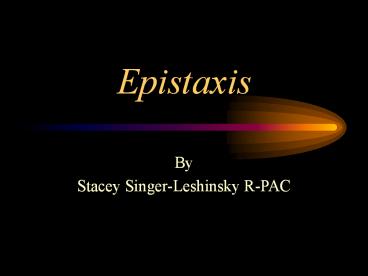Epistaxis - PowerPoint PPT Presentation
Title:
Epistaxis
Description:
Epistaxis By Stacey Singer-Leshinsky R-PAC Function of the Nose Vasculature just under the mucosa. Vasculature supply originates from the ethmoid branches of the ... – PowerPoint PPT presentation
Number of Views:936
Avg rating:3.0/5.0
Title: Epistaxis
1
Epistaxis
- By
- Stacey Singer-Leshinsky R-PAC
2
Function of the Nose
- Vasculature just under the mucosa.
- Vasculature supply originates from the ethmoid
branches of the internal carotid arteries and the
facial and internal maxillary divisions of the
external carotid arteries. - Nose bleeds are very common
3
Epistaxis
- Acute hemorrhage from the nostril, nasal cavity,
or nasopharynx. - Etiology includes infection, trauma, allergic
rhinitis, renal failure, nasal defects,
hypertension, tumors, use of blood thinners,
aspirin. - History
4
Epistaxis
- Classified by the location
- Can be either anterior or posterior.
5
Anterior Epistaxis
- Kiesselbachs plexus most common.
- Clinical Manifestations
- History
- Unilateral bleeding
- No sensation of post nasal drip
- Blood is bright red
6
Anterior Epistaxis
- Diagnostics
- Hemoglobin/Hematocrit
- CBC
- Bleeding time
7
Anterior Epistaxis
- Management
- ABC
- Direct pressure. Pinch nostrils sit forward.
- Cautery- chemical, electric, thermal. Silver
nitrate sticks - Use of vasoconstrictors sprays. / anesthetic
agents. - Anterior packing Merocel compressed sponge.
- Remove any clots visualized
- Anterior epistaxis balloons.
8
Anterior Epistaxis
- Complications of nasal packing
- Septal hematomas/abscess
- Sinusitis
- Pressure necrosis
9
Posterior Epistaxis
- Usual source is the branches of the
sphenopalatine artery. Bleeding occurs behind the
posterior portion of the middle turbinate or
posterior superior roof of the nasal cavity.
10
Posterior Epistaxis
- Clinical Manifestations
- Nausea, hematemesis, anemia, hemoptysis or
melena. - No visualized anterior source of bleeding
- Post nasal drip of blood
- Blood is dark red
- Brisk arterial bleed
11
Posterior Epistaxis
- Diagnostics
- Hemoglobin/ Hematocrit
- History of bleeding disorder
12
Posterior Epistaxis
- Management
- Attempt to locate the source
- Vasoconstrictive/ anesthetic agents
- Posterior nasal packing
- Immediate otolaryngologist referral
- Prophylactic antibiotics
- Hospitalization and monitoring
13
Posterior Epistaxis Packing
14
Posterior Epistaxis
- Indications for surgery/ embolization
- Continued bleeding with packing
- Required transfusion
- Nasal anomaly precluding packing
- Patient intolerance to packing
15
EpistaxisDifferential Diagnosis
- Local irritation
- Occupational exposure
- Allergies
- Malignancy due to systemic disease such as
granulomatous disease(Wegeners sarcoidosis) - Hereditary hemorrhagic telangiectasia(Osler-Weber-
Rendu syndrome) - Bleeding disorders
- hypertension
16
EpistaxisComplications
- Sinusitis
- Possibility of airway obstruction
- Toxic shock syndrome
- Septal hematoma or abscess
- Septal perforation
17
Osler-Weber-Rendu syndrome
- Disorder of blood vessels
- Etiology Genetic
- Clinical manifestations telangiectases on the
lips, tongue and nasal mucosa - Complications include hemorrhage































